Taking the bull by the...
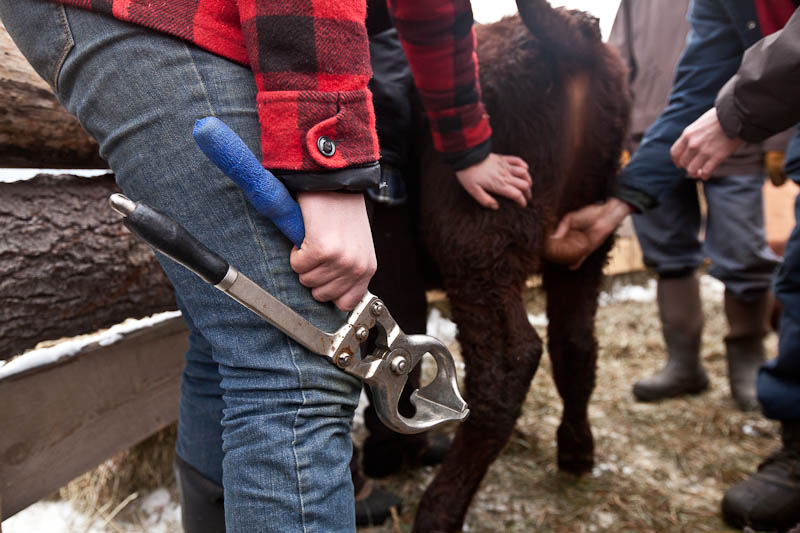 Let me be clear – there won’t be any Mary Oliver poems in this story. In fact, as you may have surmised from the above photo, things got a little, well . . . nuts on the farm this week. And if you scroll down any further, you’re going to read about – and see pictures of – five bull calves having a very bad day.We have made an effort to spare you the worst but read on at your own risk.Wednesday morning’s class was supposed to be all about raising pigs. Instead, our vet, Dr. Ledoux, showed up for – surprise! – Castration Day.Though unpleasant for both man and beast, castration is essential on the farm. Intact male bulls (those who still have their bits) are like 1,500-pound teenage boys except that they have horns to enforce their outsized libidos and appetites. Get them near the ladies, stand between them and their food or simply look at them crosswise and thing can get dangerous – fast.
Let me be clear – there won’t be any Mary Oliver poems in this story. In fact, as you may have surmised from the above photo, things got a little, well . . . nuts on the farm this week. And if you scroll down any further, you’re going to read about – and see pictures of – five bull calves having a very bad day.We have made an effort to spare you the worst but read on at your own risk.Wednesday morning’s class was supposed to be all about raising pigs. Instead, our vet, Dr. Ledoux, showed up for – surprise! – Castration Day.Though unpleasant for both man and beast, castration is essential on the farm. Intact male bulls (those who still have their bits) are like 1,500-pound teenage boys except that they have horns to enforce their outsized libidos and appetites. Get them near the ladies, stand between them and their food or simply look at them crosswise and thing can get dangerous – fast.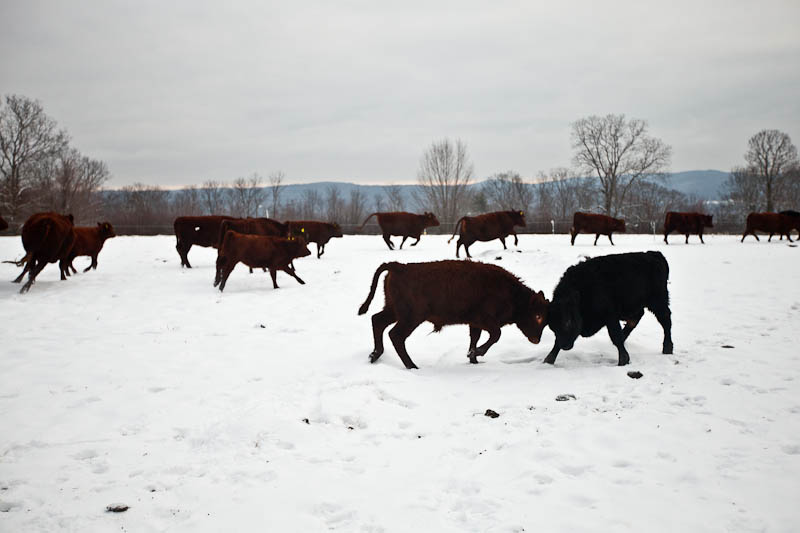 Castration is also necessary for any successful breeding program. Many herds are offspring of the same bull, so castration is necessary to prevent inbreeding. Also, farmers select for desirable traits such overall size, health and strength; general disposition, and (in the case of females) mothering skills. Those who flunk the genetic test are the first get snipped or to “graduate” (aka, go to the slaughter house).There’s also the question of taste. In pigs, hormones from a fertile male, or “boar taint,” make the meat inedible. Some say the same thing happens in cows, but a study in the Journal of Animal Science concluded that while bull meat is less marbled and is generally lower grade than steer meat, it scores comparably for flavor, juiciness and overall satisfaction.Armed with all these justifications, we gathered at the Waslowski barn for our little exercise in eugenics.First, we separated the calves from their mothers, who whimpered nervously from the other side of the fence, eyes and ears alert. Dr. Ledoux arrived and rolled out his medieval-looking set of tools and announced that this was not a demonstration. Rather, Castration Day was to be a very hands-on lesson and we were all expected to participate. At this point, I started to whimper too.
Castration is also necessary for any successful breeding program. Many herds are offspring of the same bull, so castration is necessary to prevent inbreeding. Also, farmers select for desirable traits such overall size, health and strength; general disposition, and (in the case of females) mothering skills. Those who flunk the genetic test are the first get snipped or to “graduate” (aka, go to the slaughter house).There’s also the question of taste. In pigs, hormones from a fertile male, or “boar taint,” make the meat inedible. Some say the same thing happens in cows, but a study in the Journal of Animal Science concluded that while bull meat is less marbled and is generally lower grade than steer meat, it scores comparably for flavor, juiciness and overall satisfaction.Armed with all these justifications, we gathered at the Waslowski barn for our little exercise in eugenics.First, we separated the calves from their mothers, who whimpered nervously from the other side of the fence, eyes and ears alert. Dr. Ledoux arrived and rolled out his medieval-looking set of tools and announced that this was not a demonstration. Rather, Castration Day was to be a very hands-on lesson and we were all expected to participate. At this point, I started to whimper too.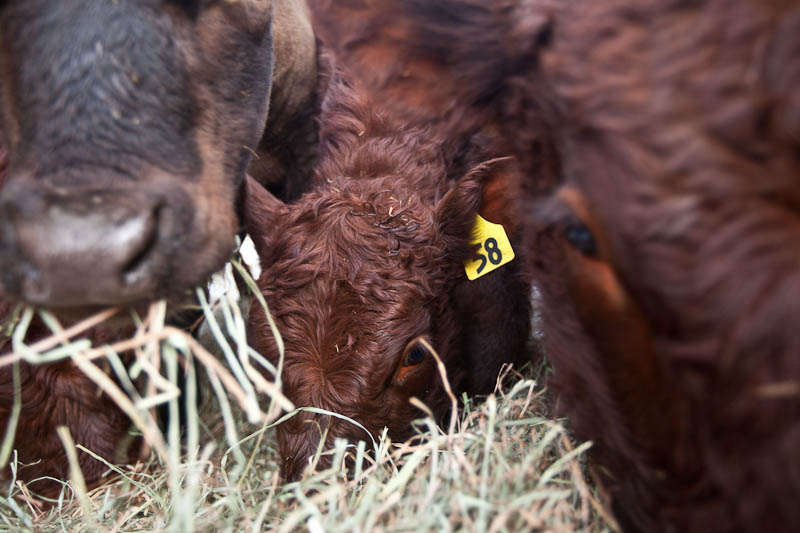 Though we didn’t anesthetize the animals, Dr. Ledoux injected each with a syringe of sedatives. Calf by calf, their chewing slowed and their eyes drooped until, eventually, all five crumpled to the ground, still aware, but unable to do much about their impending fate.We got to work.For those of you wanting to try this at home, castration can be accomplished by one of three simple methods: strangling, smashing or slicing. (Do not try this at home.)
Though we didn’t anesthetize the animals, Dr. Ledoux injected each with a syringe of sedatives. Calf by calf, their chewing slowed and their eyes drooped until, eventually, all five crumpled to the ground, still aware, but unable to do much about their impending fate.We got to work.For those of you wanting to try this at home, castration can be accomplished by one of three simple methods: strangling, smashing or slicing. (Do not try this at home.)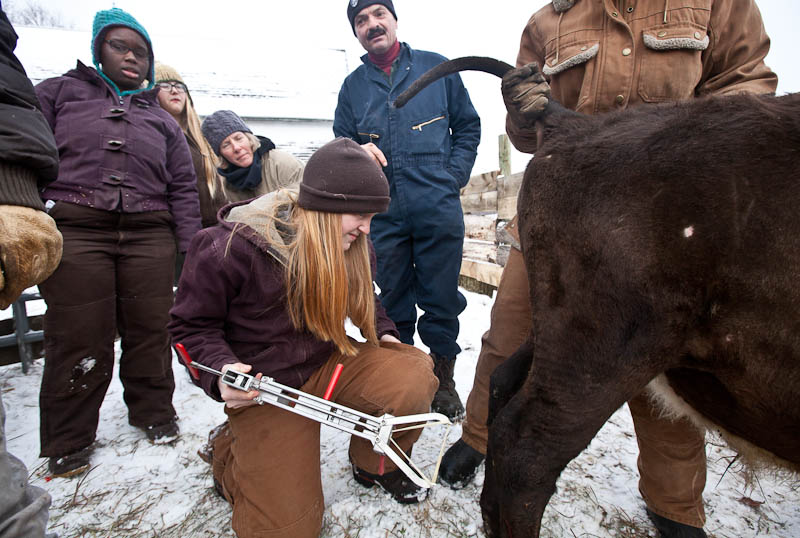 ‘Strangling’ involves looping an industrial-strength rubber band around the top of the scrotum above the testicles. Then just use your handy ‘elastrator’ tool to wrench the band as tightly as possible, thereby cutting off the blood supply to the testicles. In few weeks, the scrotum just dies and sloughs off. Whoever finds the testicles in the field later gets relieved of their chore duties for a day – the agricultural equivalent to eating King Cake on Epiphany.
‘Strangling’ involves looping an industrial-strength rubber band around the top of the scrotum above the testicles. Then just use your handy ‘elastrator’ tool to wrench the band as tightly as possible, thereby cutting off the blood supply to the testicles. In few weeks, the scrotum just dies and sloughs off. Whoever finds the testicles in the field later gets relieved of their chore duties for a day – the agricultural equivalent to eating King Cake on Epiphany.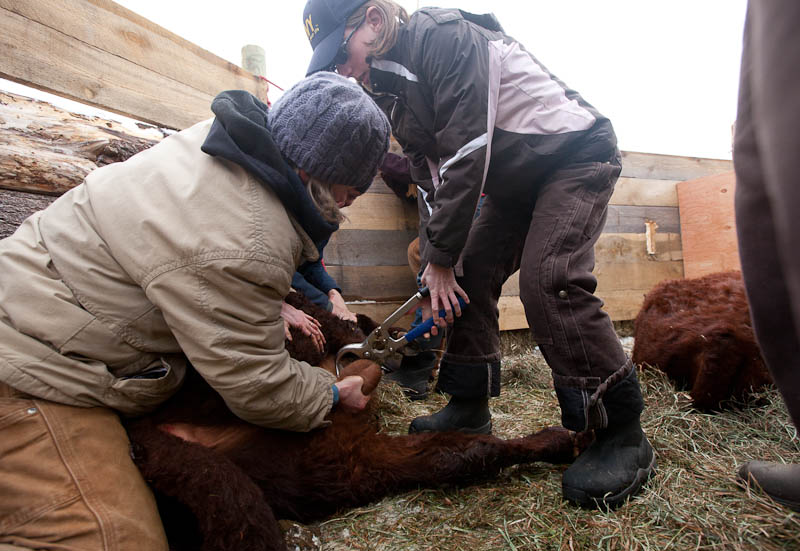 ‘Smashing’ involves an ‘emasculator’ – a tool that looks like the freakishly huge offspring of fingernail clippers and vice grips. Start by isolating the seminal vesicles, which can be found in the tender stretch of skin that connects the scrotum to the body. Open the emasculator over the scrotum and clamp down on the vesicles for 15 seconds while the cow thrashes about in protest, effectively crushing the cord and blood vessels. Repeat twice on each side. Try not to get kicked in the head. The testicles will eventually atrophy and fall off.
‘Smashing’ involves an ‘emasculator’ – a tool that looks like the freakishly huge offspring of fingernail clippers and vice grips. Start by isolating the seminal vesicles, which can be found in the tender stretch of skin that connects the scrotum to the body. Open the emasculator over the scrotum and clamp down on the vesicles for 15 seconds while the cow thrashes about in protest, effectively crushing the cord and blood vessels. Repeat twice on each side. Try not to get kicked in the head. The testicles will eventually atrophy and fall off.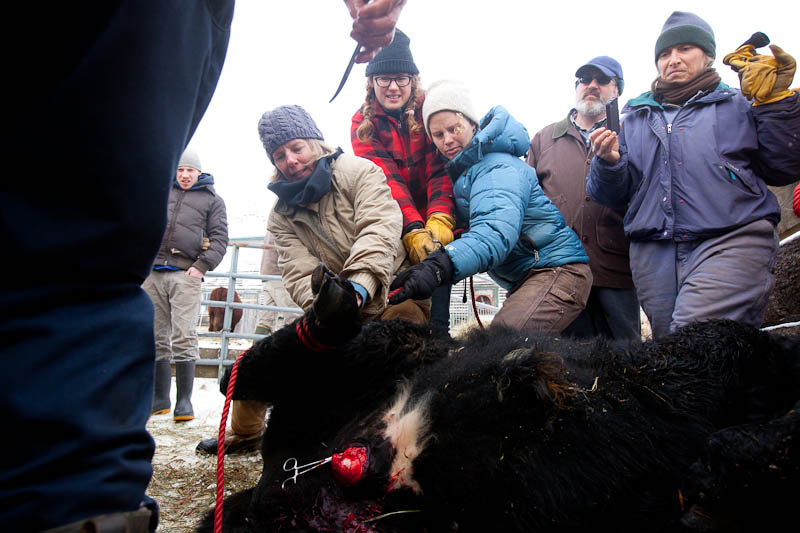 ‘Slicing’ is the most gruesome of all. Begin by using a scalpel to slice off the lower third of the scrotum. With a hole now in the sack, squeeze the testicles out like skinned, bloody grapes. A thin, filmy membrane covers them, and you can cut this away if necessary. Cut the cords that connect the testicles to the body – and don’t let go before you do, or they will fly back up into the abdomen and hide. Big time ranchers just grab the testicles and yank, tearing them away from their internal attachments. I’ve heard of others who use their teeth to sever these cords (something I will never understand). If you’re not interested in cooking ‘Rocky Mountain oysters’, (AKA prairie oysters, cowboy caviar, or swinging beef) simply toss the testicles over the fence.
‘Slicing’ is the most gruesome of all. Begin by using a scalpel to slice off the lower third of the scrotum. With a hole now in the sack, squeeze the testicles out like skinned, bloody grapes. A thin, filmy membrane covers them, and you can cut this away if necessary. Cut the cords that connect the testicles to the body – and don’t let go before you do, or they will fly back up into the abdomen and hide. Big time ranchers just grab the testicles and yank, tearing them away from their internal attachments. I’ve heard of others who use their teeth to sever these cords (something I will never understand). If you’re not interested in cooking ‘Rocky Mountain oysters’, (AKA prairie oysters, cowboy caviar, or swinging beef) simply toss the testicles over the fence.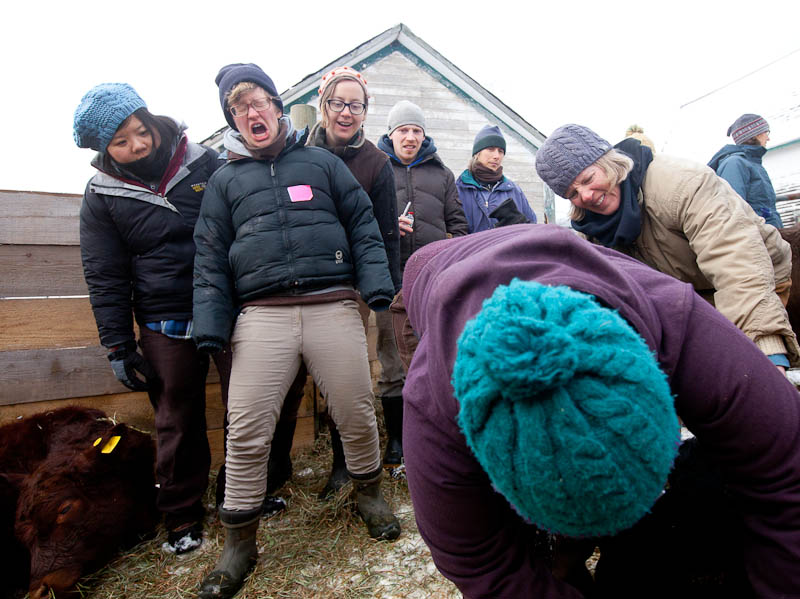 And that’s all there is to it. No stitches necessary. And as long as it isn’t fly season and your tools are clean, risk of infection is generally low, which is astounding to me considering the ubiquitous muck and dirt of a cow pasture.Until Castration Day, most of the work on the farm has been gender-neutral. But in this case, the three males of our student body (Andrew, Rich and myself) spent most of the morning pacing wide arcs around the bloodied calves and their female surgeons. Rich eventually tried his hand at the emasculator but Josh, our livestock manager declared, “Boys aren’t allowed to do this. It condemns them to immediate hell - Bad karma.”I opted to heed this advice, though I’m not proud of it. Rising to all the demands of farm life feels like an important test, be it processing turkeys, birthing lambs or harvesting endless rows of mesclun greens. But I’m pretty sure I just earned my first F.Maybe castration is like slaughtering chickens, a job that’s harder to watch than to do. I doubt it though. Despite standing at a remove, my insides were a shrinking riot of knots through the whole exercise.But the cows clearly had it worse. Humanely raised meat means just that – humane - and I’m still working out the mental gymnastics it will take to rationalize putting a creature through this. Dr. Ledoux assures us the cows don’t really feel much, or at least not in the same way we humans would, but I remain skeptical.
And that’s all there is to it. No stitches necessary. And as long as it isn’t fly season and your tools are clean, risk of infection is generally low, which is astounding to me considering the ubiquitous muck and dirt of a cow pasture.Until Castration Day, most of the work on the farm has been gender-neutral. But in this case, the three males of our student body (Andrew, Rich and myself) spent most of the morning pacing wide arcs around the bloodied calves and their female surgeons. Rich eventually tried his hand at the emasculator but Josh, our livestock manager declared, “Boys aren’t allowed to do this. It condemns them to immediate hell - Bad karma.”I opted to heed this advice, though I’m not proud of it. Rising to all the demands of farm life feels like an important test, be it processing turkeys, birthing lambs or harvesting endless rows of mesclun greens. But I’m pretty sure I just earned my first F.Maybe castration is like slaughtering chickens, a job that’s harder to watch than to do. I doubt it though. Despite standing at a remove, my insides were a shrinking riot of knots through the whole exercise.But the cows clearly had it worse. Humanely raised meat means just that – humane - and I’m still working out the mental gymnastics it will take to rationalize putting a creature through this. Dr. Ledoux assures us the cows don’t really feel much, or at least not in the same way we humans would, but I remain skeptical.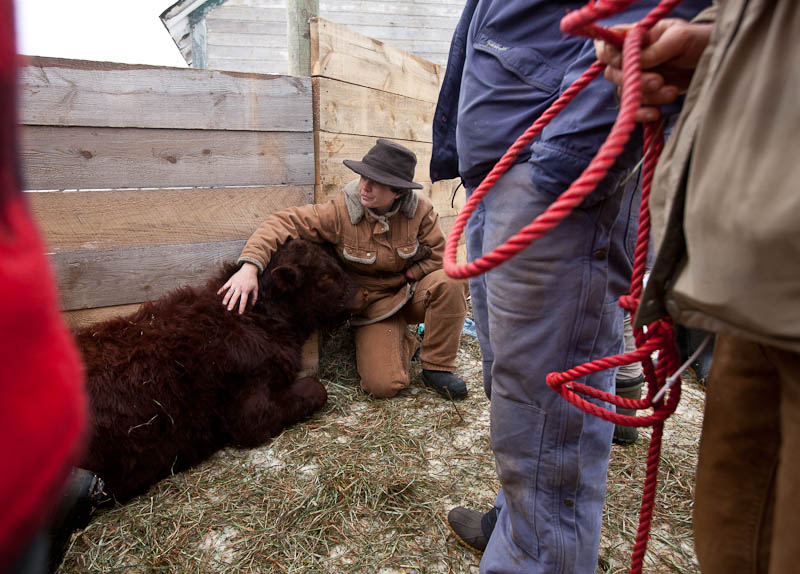 If this were my operation, I’d opt for banding, which seems to be the most humane. I think I’d do it when the cows were younger, which is less stressful according to Dr. Ledoux. Or maybe I would just pony up $50 a head for a vet to do it because I don’t know if I could physically will myself to crush, slice or band a fellow male creature’s most tender parts.Then again, Dina could probably handle it.If anyone made it through to this point and has any other advice for how to think about this business, I’m all ears (and crossed legs).
If this were my operation, I’d opt for banding, which seems to be the most humane. I think I’d do it when the cows were younger, which is less stressful according to Dr. Ledoux. Or maybe I would just pony up $50 a head for a vet to do it because I don’t know if I could physically will myself to crush, slice or band a fellow male creature’s most tender parts.Then again, Dina could probably handle it.If anyone made it through to this point and has any other advice for how to think about this business, I’m all ears (and crossed legs).
